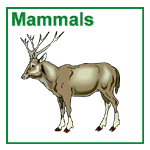Mammal Info-File |
| Habitat, range, and behavior will help you identify mammals. Mice, shrews, voles, and other small mammals may be caught in live capture traps which allow you to identify species and release them unharmed. In order to minimize the time the animal is captured, check the traps at least twice daily. Setting traps in the evening and checking in the morning is a good strategy since many small mammals are nocturnal. Animal tracks and scat can help you identify mammals. Conducting a survey after a rain or snow will increase your chances of sighting and identifying animal tracks. Note that handling animal scat can be dangerous. as it may contain parasites and diseases which are harmful to humans. Overturned rocks and stumps, marks on trees, and other visual disruptions may be signs of medium and large mammals. Raccoons will turn over rocks and stumps looking for grubs and other food. Deer will browse in woodlands and along field-woodland edges, leaving marks on the lower branches of trees. Bucks will rub their antlers on young trees, leaving marks. Info-Links
|
  White-tailed Deer © 2003, W. Saslow |
| [Search!] | [Survey] [Planning] [Projects] [Outreach] | [What's New!] |
|
Copyright © 1999-2000, REWHC. All Rights Reserved 3136 have visited |
||